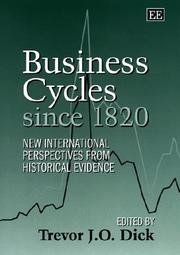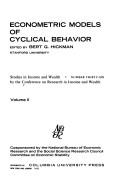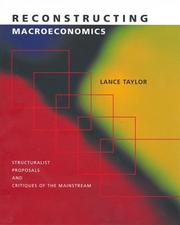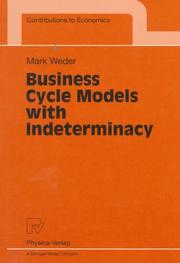| Listing 1 - 10 of 17 | << page >> |
Sort by
|
Book
ISBN: 2717828540 Year: 1995 Volume: 22 Publisher: Paris Economica
Abstract | Keywords | Export | Availability | Bookmark
 Loading...
Loading...Choose an application
- Reference Manager
- EndNote
- RefWorks (Direct export to RefWorks)
Business cycles --- Cycles économiques --- AA / International- internationaal --- 304.4 --- 331.00 --- 331.01 --- 331.04 --- 305.2 --- Cyclische veranderingen. --- Economische bewegingen: algemeenheden. --- Evolutie van de economische cycli. --- Langdurige bewegingen. --- Statistieken van de conjunctuur. --- Cycles économiques --- Business cycles. --- Economic cycles --- Economic fluctuations --- Cycles --- Cyclische veranderingen --- Statistieken van de conjunctuur --- Economische bewegingen: algemeenheden --- Evolutie van de economische cycli --- Langdurige bewegingen

ISBN: 3642488560 3790809977 Year: 1997 Publisher: Heidelberg Physica
Abstract | Keywords | Export | Availability | Bookmark
 Loading...
Loading...Choose an application
- Reference Manager
- EndNote
- RefWorks (Direct export to RefWorks)
Subject is the description of unvariate and multivariate business cycle stylized facts. A spectral analysis method (Maximum Entropy spectral estimation) novel in the analysis of economic time series is described and utilized. The method turns out to be superior to widely used time domain methods and the "classical" spectral estimate, the periodogram. The results for eleven OECD countries confirm and extend the basic set of stylized facts of traditional business cycle theory. The changing characteristics of the business cycle are analyzed by comparing the cyclical structure for the postwar and the prewar period. The results show that business cycle is mainly due to investment fluctuations.
Business & Economics --- Economic Theory --- Business cycles. --- AA / International- internationaal --- 304.4 --- 331.05 --- 331.01 --- Cyclische veranderingen. --- Econometrische analyse van de economische bewegingen en cycli. --- Evolutie van de economische cycli. --- Cycles économiques --- Economic theory. --- Economic Theory/Quantitative Economics/Mathematical Methods. --- Economic theory --- Political economy --- Social sciences --- Economic man --- Cyclische veranderingen --- Econometrische analyse van de economische bewegingen en cycli --- Evolutie van de economische cycli
Book
ISBN: 9289483660 Year: 2004 Volume: 219 Publisher: Brussels European commission. Directorate-general for economic and financial affairs
Abstract | Keywords | Export | Availability | Bookmark
 Loading...
Loading...Choose an application
- Reference Manager
- EndNote
- RefWorks (Direct export to RefWorks)
Gross domestic product --- Produit intérieur brut --- EEC / European Union - EU -Europese Unie - Union Européenne - UE --- 331.030 --- 304.4 --- 331.061 --- 305.2 --- Conjunctuurschommelingen: algemeenheden. --- Cyclische veranderingen. --- Economische vooruitzichten. --- Statistieken van de conjunctuur. --- Working papers --- Produit intérieur brut --- Conjunctuurschommelingen: algemeenheden --- Cyclische veranderingen --- Economische vooruitzichten --- Statistieken van de conjunctuur
Book
ISBN: 9789812832764 9812832769 9786612760372 1282760378 9812832785 9789812832788 Year: 2010 Publisher: Singapore ; Hackensack, NJ : World Scientific,
Abstract | Keywords | Export | Availability | Bookmark
 Loading...
Loading...Choose an application
- Reference Manager
- EndNote
- RefWorks (Direct export to RefWorks)
This title provides an overview of the modern theory and empirics of business cycles. The book examines the notion of a business cycle and discusses alternative approaches to modelling. It also discusses what lies ahead for modern business cycle theory.
AA / International- internationaal --- 331.01 --- 304.4 --- 305.2 --- Evolutie van de economische cycli. --- Cyclische veranderingen. --- Statistieken van de conjunctuur. --- Business cycles. --- Cycles économiques --- Economic cycles --- Economic fluctuations --- Business cycles --- Cycles --- Cyclische veranderingen --- Statistieken van de conjunctuur --- Evolutie van de economische cycli --- E-books

ISBN: 1858983509 Year: 1998 Publisher: Cheltenham Edward Elgar
Abstract | Keywords | Export | Availability | Bookmark
 Loading...
Loading...Choose an application
- Reference Manager
- EndNote
- RefWorks (Direct export to RefWorks)
Business cycles --- anno 1900-1999 --- anno 1800-1899 --- Business cycles. --- AA / International- internationaal --- 304.4 --- 331.05 --- 331.00 --- 304.2 --- 338.542 --- Economic cycles --- Economic fluctuations --- Cycles --- Financial crises --- Cyclische veranderingen. --- Econometrische analyse van de economische bewegingen en cycli. --- Economische bewegingen: algemeenheden. --- Trendanalyse. Tendenties van lange duur. --- Trendanalyse. Tendenties van lange duur --- Cyclische veranderingen --- Economische bewegingen: algemeenheden --- Econometrische analyse van de economische bewegingen en cycli
Book
ISBN: 0631152717 9780631152712 Year: 1989 Publisher: Oxford Blackwell
Abstract | Keywords | Export | Availability | Bookmark
 Loading...
Loading...Choose an application
- Reference Manager
- EndNote
- RefWorks (Direct export to RefWorks)
Business cycles --- Macroeconomics --- 330.33 --- AA / International- internationaal --- 304.4 --- 331.00 --- 330.00 --- 331.01 --- 331.04 --- 330.01 --- Conjunctuurtheorieen. Krisistheorieen. Kondratiefcyclus --- Cyclische veranderingen. --- Economische bewegingen: algemeenheden. --- Economische en sociale theorieën: algemeenheden. --- Evolutie van de economische cycli. --- Langdurige bewegingen. --- Theorie van het economisch evenwicht. --- 330.33 Conjunctuurtheorieen. Krisistheorieen. Kondratiefcyclus --- Conjunctuur --- Cyclische veranderingen --- Economische bewegingen: algemeenheden --- Economische en sociale theorieën: algemeenheden --- Evolutie van de economische cycli --- Langdurige bewegingen --- Theorie van het economisch evenwicht

ISBN: 0870142321 0870142577 9780870142321 9780870142574 Year: 1972 Volume: 36 Publisher: New York Columbia University Press
Abstract | Keywords | Export | Availability | Bookmark
 Loading...
Loading...Choose an application
- Reference Manager
- EndNote
- RefWorks (Direct export to RefWorks)
Business cycles --- Quantitative methods (economics) --- United States --- Mathematical models --- Economic conditions --- AA / International- internationaal --- 304.4 --- 331.05 --- 331.061 --- 330.3 --- Cyclische veranderingen. --- Econometrische analyse van de economische bewegingen en cycli. --- Economische vooruitzichten. --- Methode in staathuishoudkunde. Statische, dynamische economie. Modellen. Experimental economics. --- Conferences - Meetings --- Cyclische veranderingen --- Econometrische analyse van de economische bewegingen en cycli --- Economische vooruitzichten --- Methode in staathuishoudkunde. Statische, dynamische economie. Modellen. Experimental economics --- Business cycles - Mathematical models - Congresses --- United States - Economic conditions - Mathematical models - Congresses

ISBN: 0674010736 0674044231 9780674044234 9780674010734 Year: 2004 Publisher: Cambridge, Mass. Harvard University Press
Abstract | Keywords | Export | Availability | Bookmark
 Loading...
Loading...Choose an application
- Reference Manager
- EndNote
- RefWorks (Direct export to RefWorks)
Macroeconomics is in disarray. No one approach is dominant, and an increasing divide between theory and empirics is evident. This book presents both a critique of mainstream macroeconomics from a structuralist perspective and an exposition of modern structuralist approaches. The fundamental assumption of structuralism is that it is impossible to understand a macroeconomy without understanding its major institutions and distributive relationships across productive sectors and social groups. Lance Taylor focuses his critique on mainstream monetarist, new classical, new Keynesian, and growth models. He examines them from a historical perspective, tracing monetarism from its eighteenth-century roots and comparing current monetarist and new classical models with those of the post-Wicksellian, pre-Keynesian generation of macroeconomists. He contrasts the new Keynesian vision with Keynes's General Theory, and analyzes contemporary growth theories against long traditions of thought about economic development and structural change. Table of Contents: Acknowledgments Introduction 1. Social Accounts and Social Relations 1. A Simple Social Accounting Matrix 2. Implications of the Accounts 3. Disaggregating Effective Demand 4. A More Realistic SAM 5. Stock-Flow Relationships 6. A SAM and Asset Accounts for the United States 7. Further Thoughts 2. Prices and Distribution 1. Classical Macroeconomics 2. Classical Theories of Price and Distribution 3. Neoclassical Cost-Based Prices 4. Hat Calculus, Measuring Productivity Growth, and Full Employment Equilibrium 5. Mark-up Pricing in the Product Market 6. Efficiency Wages for Labor 7. New Keynesian Crosses and Methodological Reservations 8. First Looks at Inflation 3. Money, Interest, and Inflation 1. Money and Credit 2. Diverse Interest Theories 3. Interest Rate Cost-Push 4. Real Interest Rate Theory 5. The Ramsey Model 6. Dynamics on a Flying Trapeze 7. The Overlapping Generations Growth Model 8. Wicksell's Cumulative Process Inflation Model 9. More on Inflation Taxes 4. Effective Demand and Its Real and Financial Implications 1. The Commodity Market 2. Macro Adjustment via Forced Saving and Real Balance Effects 3. Real Balances, Input Substitution, and Money Wage Cuts 4. Liquidity Preference and Marginal Efficiency of Capital 5. Liquidity Preference, Fisher Arbitrage, and the Liquidity Trap 6. The System as a Whole 7. The IS/LM Model 8. Keynes and Friends on Financial Markets 9. Financial Markets and Investment 10. Consumption and Saving 11 "Disequilibrium" Macroeconomics 12. A Structuralist Synopsis 5. Short-Term Model Closure and Long-Term Growth 1. Model "Closures" in the Short Run 2. Graphical Representations and Supply-Driven Growth 3. Harrod, Robinson, and Related Stories 4. More Stable Demand-Determined Growth 6. Chicago Monetarism, New Classical Macroeconomics, and Mainstream Finance 1. Methodological Caveats 2. A Chicago Monetarist Model 3. A Cleaner Version of Monetarism 4. New Classical Spins 5. Dynamics of Government Debt 6. Ricardian Equivalence 7. The Business Cycle Conundrum 8. Cycles from the Supply Side 9. Optimal Behavior under Risk 10. Random Walk, Equity Premium, and the Modigliani-Miller Theorem 11. More on Modigliani-Miller 12. The Calculation Debate and Super-Rational Economics 7. Effective Demand and the Distributive Curve 1. Initial Observations 2. Inflation, Productivity Growth, and Distribution 3. Absorbing Productivity Growth 4. Effects of Expansionary Policy 5. Financial Extensions 6. Dynamics of the System 7. Comparative Dynamics 8. Open Economy Complications 8. Structuralist Finance and Money 1. Banking History and Institutions 2. Endogenous Finance 3. Endogenous Money via Bank Lending 4. Money Market Funds and the Level of Interest Rates 5. Business Debt and Growth in a Post-Keynesian World 6. New Keynesian Approaches to Financial Markets 9. A Genus of Cycles 1. Goodwin's Model 2. A Structuralist Goodwin Model 3. Evidence for the United States 4. A Contractionary Devaluation Cycle 5. An Inflation Expectations Cycle 6. Confidence and Multiplier 7. Minsky on Financial Cycles 8. Excess Capacity, Corporate Debt Burden, and a Cold Douche 9. Final Thoughts 10. Exchange Rate Complications 1. Accounting Conundrums 2. Determining Exchange Rates 3. Asset Prices, Expectations, and Exchange Rates 4. Commodity Arbitrage and Purchasing Power Parity 5. Portfolio Balance 6. Mundell-Fleming 7. IS/LM Comparative Statics 8. UIP and Dynamics 9. Open Economy Monetarism 10. Dornbusch 11. Other Theories of the Exchange Rate 12. A Developing Country Debt Cycle 13. Fencing in the Beast 11. Growth and Development Theories 1. New Growth Theories and Say's Law 2. Distribution and Growth 3. Models with Binding Resource or Sectoral Supply Constraints 4. Accounting for Growth 5. Other Perspectives 6. The Mainstream Policy Response 7. Where Theory Might Sensibly Go References Index Reconstructing Macroeconomics is a stunning intellectual achievement. It surveys an astonishing range of macroeconomic problems and approaches in a compact, coherent critical framework with unfailing depth, wit, and subtlety. Lance Taylor's pathbreaking work in structural macroeconomics and econometrics sets challenging standards of rigor, realism, and insight for the field. Taylor shows why the structuralist and Keynesian insistence on putting accounting consistency, income distribution, and aggregate demand at the center of macroeconomic analysis is indispensable to understanding real-world macroeconomic events in both developing and developed economies. The book is full of new results, modeling techniques, and shrewd suggestions for further research. Taylor's scrupulous and balanced appraisal of the whole range of macroeconomic schools of thought will be a source of new perspectives to macroeconomists of every persuasion.--Duncan K. Foley, New School UniversityLance Taylor has produced a masterful and comprehensive critical survey of existing macro models, both mainstream and structuralist, which breaks considerable new ground. The pace is brisk, the level is high, and the writing is entertaining. The author's sense of humor and literary references enliven the discussion of otherwise arcane and technical, but extremely important, issues in macro theory. This book is sure to become a standard reference that future generations of macroeconomists will refer to for decades to come.--Robert Blecker, American UniversityWhile there are other books dealing with heterodox macroeconomics, this book surpasses them all in the quality of its presentation and in the careful treatment and criticism of orthodox macroeconomics including its recent contributions. The book is unique in the way it systematically covers heterodox growth theory and its relations to other aspects of heterodox macroeconomics using a common organizing framework in terms of accounting relations, and in the way it compares the theories with mainstream contributions. Another positive and novel feature of the book is that it takes a long view of the development of economic ideas, which leads to a more accurate appreciation of the real contributions by recent theoretical developments than is possible in a presentation that ignores the history of macroeconomics.--Amitava Dutt, University of Notre Dame
Macroeconomics --- Mathematical models --- AA / International- internationaal --- 304.4 --- 331.05 --- 303.8 --- 331.04 --- 304.2 --- Cyclische veranderingen. --- Econometrische analyse van de economische bewegingen en cycli. --- Econometrische behandeling van een onderwerp. --- Langdurige bewegingen. --- Trendanalyse. Tendenties van lange duur. --- Macroeconomics. --- Mathematical models. --- Economics --- Econometrische behandeling van een onderwerp --- Trendanalyse. Tendenties van lange duur --- Cyclische veranderingen --- Langdurige bewegingen --- Econometrische analyse van de economische bewegingen en cycli --- Macroeconomics - Mathematical models

ISBN: 3790810789 3642470181 Year: 1998 Publisher: Heidelberg Physica
Abstract | Keywords | Export | Availability | Bookmark
 Loading...
Loading...Choose an application
- Reference Manager
- EndNote
- RefWorks (Direct export to RefWorks)
Three original models which explain business cycles as a result of self-fulfilling expectations are presented. The models are founded on the structue of dynamic general equilibrium theory. Market power and increasing returns to scale are introduced which allow indeterminancy of the Rational Expectations equilibria to be obtained. Unlike the majority of existing literature on this subject, the departures from perfect markets and constant returns presented in these models are very low and, more importantly, at a realistic level to achieve the respective results. The model is structured in the tradition of the Real Business Cycle approach to fluctuations. The time series of the stochastic version of the model act as a factor to measure success. However, shocks generally derive from demand disturbances (animal spirits) alone to produce these results. It is demonstrated in all of the presented models that stylized facts of the business cycle can be reproduced.
Business cycles --- Equilibrium (Economics) --- Rational expectations (Economic theory) --- Mathematical models. --- AA / International- internationaal --- 304.4 --- 331.05 --- 331.00 --- 330.3 --- Cyclische veranderingen. --- Econometrische analyse van de economische bewegingen en cycli. --- Economische bewegingen: algemeenheden. --- Methode in staathuishoudkunde. Statische, dynamische economie. Modellen. Experimental economics. --- Mathematical models --- Cyclische veranderingen --- Methode in staathuishoudkunde. Statische, dynamische economie. Modellen. Experimental economics --- Econometrische analyse van de economische bewegingen en cycli --- Economic theory. --- Economic Theory/Quantitative Economics/Mathematical Methods. --- Economic theory --- Political economy --- Social sciences --- Economic man --- Economische bewegingen: algemeenheden
Book
ISBN: 9264299416 9264299424 Year: 2004 Publisher: Paris OCDE
Abstract | Keywords | Export | Availability | Bookmark
 Loading...
Loading...Choose an application
- Reference Manager
- EndNote
- RefWorks (Direct export to RefWorks)
croissance economique --- developpement economique --- politique economique --- pays de l'ocde --- AA / International- internationaal --- 304.4 --- 338.8 --- 331.04 --- 304.2 --- economische groei --- economische ontwikkeling --- economisch beleid --- oeso landen --- Cyclische veranderingen. --- Economische groei. --- Langdurige bewegingen. --- Trendanalyse. Tendenties van lange duur. --- Industrial productivity --- Productivité --- OECD countries --- Pays de l'OCDE --- Economic conditions --- Economic policy --- Conditions économiques --- Politique économique --- Cyclische veranderingen --- Economische groei --- Langdurige bewegingen --- Trendanalyse. Tendenties van lange duur
| Listing 1 - 10 of 17 | << page >> |
Sort by
|

 Search
Search Feedback
Feedback About
About Help
Help News
News